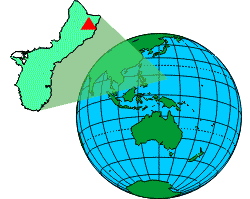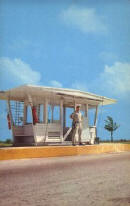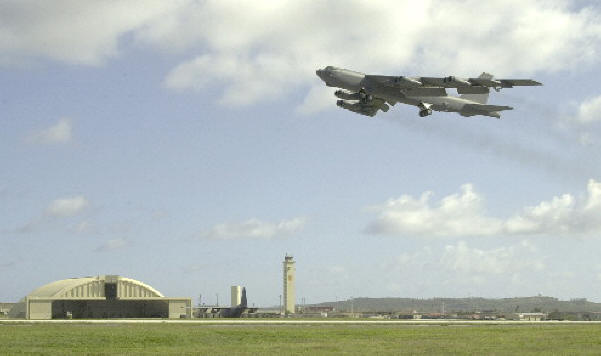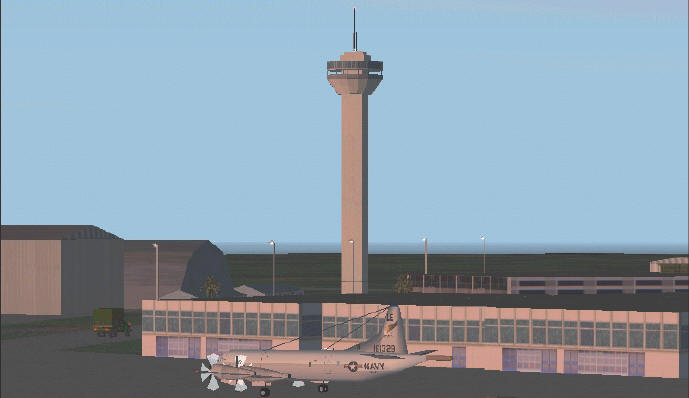| SAC Bases: Andersen
Air Force Base |
|
 |
Andersen Air Force
Base is a 20,000-acre site located in the city of Yigo on the northern end
of the island of Guam. Operational since 1940, AAFB's main
purpose has been to provide support for Strategic Air Command operations.
The 3960th Strategic
Wing was a early to mid 1960's B-52 and KC-135
controlling unit from Andersen AFB, Guam. It was used until B-52's and tankers
began to sink the Island under their rapidly increasing build-up and required a
better command structure. Andersen Air Force Base is home to Pacific Air Forces’ 13th Air Force and the
36th Air Base Wing, Air Mobility Command’s 634th Air Mobility Support Squadron
and several other tenant organizations. |
 |
|

|
In 1950, Congress passed the Organic Act, which gave Chamorros citizenship,
and Guam became an organized unincorporated territory of the United States. The
president appointed the governor, and the administration fell under the
jurisdiction of the Department of the Interior. Guam's first popularly elected
governor took office in 1971. Guam elected its first delegate to the U.S.
Congress in 1972.
Guam is only three jet-hours away from the Asian capitals of Tokyo, Taipei
and Manila, and it welcomed more than 1 million tourists in 1999. The island is
Japan's playground. Situated in the Western Pacific, across the International
Date Line at 13°28" north latitude and 114°45" east longitude, it is the largest
of more than 2,000 islands scattered between Hawaii and the Philippines. With
about 150,000 residents and more than 13,000 military personnel and their family
members, Guam is the most populated island in the geographical area known as
Micronesia. Two hundred and twelve square miles in size, the island is part of
an underwater mountain range running southward from Japan, and is the
southernmost island in the Marianas archipelago.
Andersen traces its roots back to a tent on Pati Point in 1944 during the
early days of World War II when four men of the 854th Airfield Construction
Battalion "Spearheaders" stood at a drafting table, drawing lines on a
blueprint. Those lines would define the runways, taxiways and parking aprons
that would later become Andersen Air Force Base. The area on Guam on which the
Spearheaders drew the lines was known as a forest area – an almost impenetrable
stand of trees and brush that covered the northern end of Guam. By February
1945, a runway complex was operational at what was then known as North Field. By
June the finishing touches were almost complete and North Field aircraft began
daily bombing missions over Japan.
The field was redesignated North Guam Air Force Base in 1947 – the same year
the Air Force became a separate service. Two years later, the base was renamed
in honor of Brig. Gen. Roy Andersen. Andersen had been chief of staff at Harmon
Field, Guam, when his aircraft disappeared en route to Hawaii in February 1945. |
|

|
|
When fighting erupted in Korea, Guam became a focal point for aircraft and
material flying west. In 1951, Andersen began supporting rotational bomber
deployments from stateside bases, first with B-29s, and eventually hosting B-36,
B-47 and, in 1964, B-52 units.
For the next six years, Strategic Air Command trained and practiced its
wartime skills – which would be tested time and time again as the conflict in
Southeast Asia escalated. Andersen would play a major part in the Vietnam
conflict, when 27 B-52 bombers were launched from its runway June 18, 1965. The
aircraft initiated Operation Arc Light, bombing missions over North and South
Vietnam to strike Viet Cong base operations and enemy troop concentrations and
supply lines. Arc Light missions continued for eight years.
In 1972 Andersen was the site of the most massive build up of airpower in
history. More than 15,000 people and more than 150 B-52s lined all available
flight line space. During Operation Linebacker II in December 1972, bombers
stationed at Andersen flew 729 sorties in 11 days, resulting in renewed peace
talks in Paris.
The post-Vietnam period brought a return to routine operations at Andersen,
with the base remaining a vital overseas platform for carrying Strategic Air
Command’s global-deterrence mission. In October 1988, the host 43rd Bombardment
Wing traded its nuclear-deterrent role for a conventional mission. One year
later, the bomb wing began redeploying to stateside bases, and Andersen
transitioned from SAC to Pacific Air Forces with the activation of the 633rd Air
Base Wing. The 43rd BW was officially inactivated Sept. 30, 1990. As part of an
Air Force-wide initiated to preserve the heritage of the Air Force’s
most-decorated units, the 633rd ABW inactivated Sept. 30, 1994, and was
redesignated the 36th Air Base Wing. Since the airfield became operational as North Field in 1945, it has
continually played vital roles in maintaining U.S. presence in the Pacific.
Aircraft flying in and out of Andersen participated in both world wars, the
conflict on the Korean peninsula, the Vietnam conflict, and Operations Desert
Shield and Storm.
Andersen forces also played a key role in Operation New Life, the evacuation
of thousands after the fall of Saigon in 1975. During New Life, Andersen
received more than 40,000 refugees and processed another 109,000 for onward
transportation to the United States mainland. Andersen also played a key role in
Operation Baby Lift, an element of New Life in which the U.S. evacuated 1,500
orphans from Vietnam and Thailand in April 1975.
In recent years, Andersen played a vital role in Operation Fiery Vigil, the
evacuation of the Philippines following the eruption of Mount Pinatubo in June
1991, and Joint Task Force Pacific Haven, the evacuation of more than 6,000
Kurdish people from Northern Iraq in September 1996. Today, with huge fuel and
munitions storage facilities and dual two-mile-long runways, Andersen is an
important forward-based logistics-support center for exercise and contingency
forces deploying throughout the Southwest Pacific and Indian Ocean area.
Andersen 3rd AD / 8th AF 3960 SW / Bomb Wing (Provisional)
- 4133 Later R/D 43rd Strategic Wing/ 43rd Bomb Wing (during 1972-73 Air
Division (Provisional) 57 Bomb Wing (Provisional) 72, Consolidated Aircraft Maintenance
Wing (Provisional) - 303 + 5 es Bomb Squadron (Provisional) units & the PCS
60th BS
|
|

|
|
